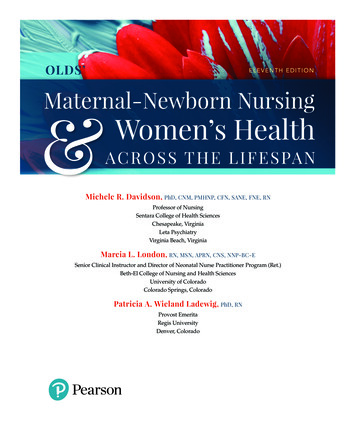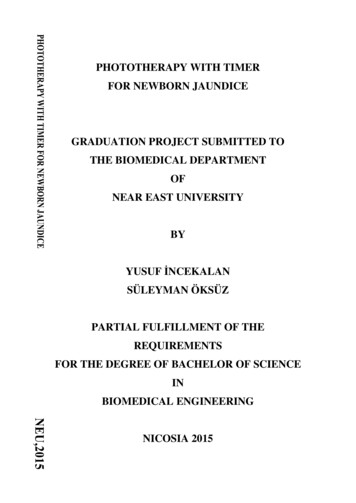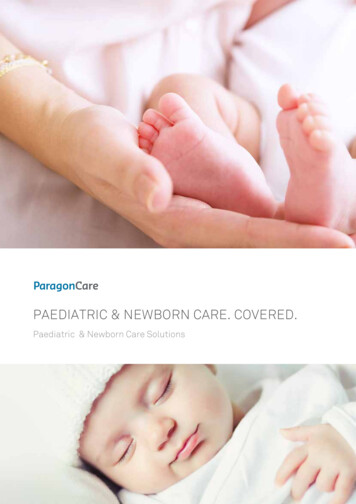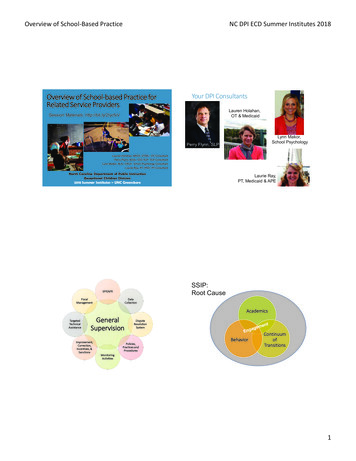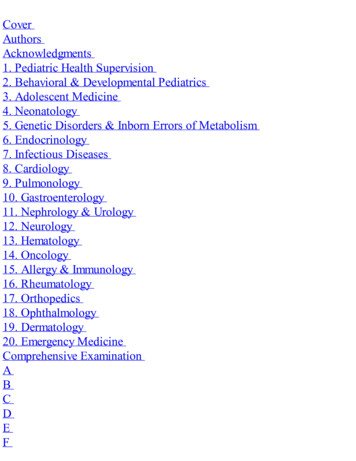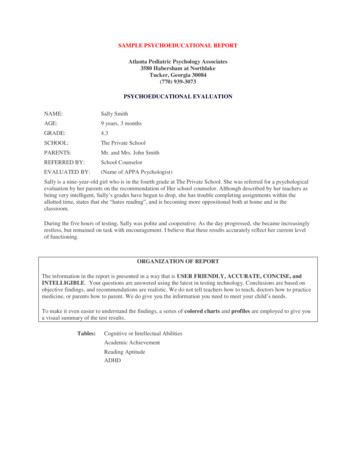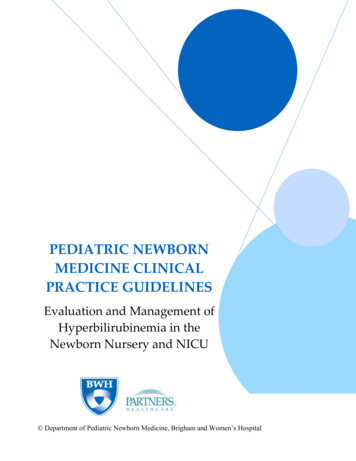
Transcription
PEDIATRIC NEWBORNMEDICINE CLINICALPRACTICE GUIDELINESEvaluation and Management ofHyperbilirubinemia in theNewborn Nursery and NICU Department of Pediatric Newborn Medicine, Brigham and Women’s Hospital
PEDIATRIC NEWBORN MEDICINE CLINICAL PRACTICE GUIDELINESClinical Guideline NameEvaluation and Management of Hyperbilirubinemia in the NewbornNursery and NICUImplementation DateMarch 1, 2016Due for CPC ReviewContact PersonMedical Director, NICUApproved ByDepartment of Pediatric Newborn Medicine Clinical PracticeCouncil 1/14/16CWN PPG 1/13/16BWH SPP Steering 2/17/16Nurse Executive Board/CNO 2/22/16I. PurposeThe purpose of this clinical practice guideline is to ensure that all infants receive optimal and consistentcare for hyperbilirubinemia by establishing standard practices for the evaluation and management ofhyperbilirubinemia in preterm and term infants.II. All CPGs will rely on the NICU Nursing Standards of Care. All relevant nursing PPGs arelisted below (all underlined text is hyperlinks):WNH P.1 Phototherapy for InfantsWNH B.8 Infant Bilirubin ScreeningWNH B.2 Infant Heelstick Blood SamplingWNH ---- Care of the Late Preterm InfantIVIG DAGIII. ScopeThese guidelines apply to all infants in the care of the Department of Pediatric Newborn Medicine. Theguidelines include recommendations for evaluation, diagnosis and monitoring of hyperbilirubinemia,as well as indications for administration of phototherapy, intravenous immunoglobulin (IVIG) andexchange transfusion.IV. Etiology and Evaluation Every infant with jaundice should be evaluated for etiology and severity of hyperbilirubinemiato guide appropriate therapyFor jaundice appearing ono Day 1: consider isoimmunization (ex. Rh, ABO incompatibility) and congenitalinfection If mother is blood type O , obtain infant blood type and direct antiglobulin test(DAT) Department of Pediatric Newborn Medicine, Brigham and Women’s Hospital
PEDIATRIC NEWBORN MEDICINE CLINICAL PRACTICE GUIDELINES o Days 2-6: consider bacterial infection (including urinary tract infection), resorptionjaundice (ex. cephalohematoma), metabolic disease (ex. galactosemia),isoimmunization, congenital infection, breastfeeding jaundice/dehydration, physiologicjaundice, RBC membrane defects (ex. spherocytosis), RBC enzyme defects (ex. G6PDdeficiency, pyruvate kinase deficiency) Obtain blood type, DAT, hematocrit, reticulocyte count, and blood smear If hemolysis is present with negative DAT, check RBC enzymes If elevation of direct bilirubin, obtain urinalysis and urine culture and evaluatecauses of cholestasiso Days 7 : Indirect (unconjugated) hyperbilirubinemia: consider breast milk jaundice,hypothyroidism, sepsis Direct (conjugated) hyperbilirubinemia: evaluate causes of cholestasisJaundice appearing within 24 hours of life is pathologic until proven otherwiseIt is crucial to determine presence or absence of hemolysisThe total serum bilirubin (TSB) level is used when determining levels for phototherapy orexchange transfusionPhysiologic hyperbilirubinemia is a diagnosis of exclusion. Persistent hyperbilirubinemia in annon-breast fed infant should be considered abnormal, and warrants further investigationV. Assessing riska. Major risk factors for developing severe hyperbilirubinemia:o TSB in the high risk zone of the Bhutani nomogramo Jaundice observed in first 24 hours of lifeo Blood group incompatibility (Rh or ABO) or known hemolytic diseaseo If mother is blood type O , obtain infant blood type and DATo Prematurityo Cephalohematoma, subgaleal hemorrhage, or other significant bruisingo Previous sibling with hyperbilirubinemia requiring phototherapyo Exclusive breastfeeding, particularly in setting of excessive weight losso East Asian raceb. Use of nomograms: Nomograms help assess risk for developing hyperbilirubinemia and assist in determiningthe timing of appropriate follow-up Bhutani curve (below) is the accepted nomogram for assessing hyperbilirubinemia risk forinfants 35 weeks gestation, based on bilirubin level and postnatal age Department of Pediatric Newborn Medicine, Brigham and Women’s Hospital
PEDIATRIC NEWBORN MEDICINE CLINICAL PRACTICE GUIDELINESBhutani nomogram ( 35 weeks gestation):Bhutani et al. nomogram for well newborns at 36 weeks’ gestational age with birth weight of 2000 g or more or 35 weeks’ gestational ageand birth weight of 2500 g based on hour-specific serum bilirubin values.c.Bilitool: Bilitool (www.bilitool.org) is a web site that provides a free, user-friendly, interactive wayto match infant bilirubin levels with the Bhutani nomogram and established phototherapyguidelines (for infants 35 weeks)VI. Light source and irradiance Blue fluorescent lamps or LED systems (ex. neoBLUE ) provide irradiance in the 430 –490 nm band and are determined to be the most effective light source for phototherapyo LED lights provide the greatest TSB decrease during first 24 hours, followed byspotlights, bank of lights, and blanketsIf TSB continues to rise despite phototherapy, consider increasing irradiance by bringingphototherapy lamp closer to infant or increasing body surface area exposed to phototherapy(ex. place additional light source beneath infant and reflecting material around incubator orradiant warmer)Use radiometer recommended by manufacturer of phototherapy system to measureirradiance (Biomed) Department of Pediatric Newborn Medicine, Brigham and Women’s Hospital
PEDIATRIC NEWBORN MEDICINE CLINICAL PRACTICE GUIDELINES Due to increased mortality associated with phototherapy use in ELBW infants, if BW 750g, consider initiating phototherapy at lower irradiance level (i.e. “low” setting) and onlyincrease irradiance (or surface area exposed) if TSB continues to riseVII. Infants 35 weeks gestationa. Key points: TSB levels progressively increase during the first 96-120 hours after birth and usuallydecline depending on the maturation of the infant’s liver, initiation of enteral feeds, 35NICUOutput depends on distance from lensto infantUtilizes white lightTo be discontinued by GE andreplaced with blue LED spotlights12-15 (low)NICU,Newborn NurseryBoth low and high settings assumedistance of 12” from light to infantUtilizes blue LEDNICUUtilizes blue LEDNewborn NurseryNewborn NurseryUtilizes blue LEDUtilizes blue fluorescent tubeNICU,Newborn NurseryUsed rarely in NICUGiraffe Spot PT Lite (GE)NeoBlue (Natus)BiliSoft Blanket (GE)NeoBlue Cozy Bed (Natus)BiliBed (Medela)BiliBlanket Plus(Datex-Ohmeda) 30-35 (high)70 (small pad)49 (large pad)30-3540-6015 (low)25 (medium)35 (high)of the GI tract, and infant’s ability to clear the bilirubin loadi. Note: TSB levels in late preterm infants may peak later (as compared with terminfants), and rate of rise may be steeperJaundice should resolve by 2 weeks of life in most infants; persistent jaundice beyond age 2weeks warrants further investigationb. Bilirubin measurement: Initial transcutaneous bilirubin (TcB) measurement should be obtained around the time ofthe initial newborn screen (between 24-48 hours of life)o Note, if mother is blood type O and Coombs is positive, TcB should be obtainedat 12 hours of life and further close follow-up recommended If TcB level is above the threshold (use table below), obtain a serum bilirubin (TSB)Postnatal age(hours)24-36 hThreshold transcutaneous bilirubin level(mg/dL)7 Department of Pediatric Newborn Medicine, Brigham and Women’s Hospital
PEDIATRIC NEWBORN MEDICINE CLINICAL PRACTICE GUIDELINES37-48 h49-72 h72-96 h96 h 8101214If major risk factors are present (see below), or if infant appears jaundiced, considerobtaining initial TcB at earlier time pointNote: in NICU setting, consider obtaining TSB (instead of TcB) to coincide with scheduledblood drawNote: TcB measurement may be used on infants of any race or ethnic background butresults may be mildly affected by skin pigmentationo TcB typically overestimates TSB in infants who are dark-skinned, and likelyunderestimates TSB in light-skinned infantsc. Risk factors for bilirubin toxicity: Hemolysis G6PD deficiency Asphyxia Neurological signs including significant lethargy or irritability Temperature instability Confirmed or suspected sepsis Acidosis Hypoalbuminemia ( 3 g/dL in near term and term infants)d. Phototherapy:Guideline for initiating phototherapy ( 35 weeks gestation) Department of Pediatric Newborn Medicine, Brigham and Women’s Hospital
PEDIATRIC NEWBORN MEDICINE CLINICAL PRACTICE GUIDELINESe. Ongoing monitoring: Obtain daily morning (04:00) TcB until downtrending If TcB level is above the threshold (use table in section VII. b above), obtain TSB Once phototherapy has been initiated:o Follow serial TSB levels (TcB levels will no longer be accurate)o Repeat TSB in 12-24 hours after starting phototherapyo For bilirubin levels approaching exchange level or rapid rate of rise morefrequent bilirubin measurements are recommendedo Use bilitool.org for specific recommendations regarding timing of serial TSBmeasurements Decisions regarding when to discontinue phototherapy should be based on the infant’sindividual risk factors and clinical situation Measure bilirubin within 12-24 hours after phototherapy is discontinued, then asclinically indicated (i.e. in setting of ongoing hemolysis) Consult with neonatologist if TSB is within 2 mg/dL of exchange transfusion threshold,or earlier as clinically indicated (ex. presence of hemolysis or other major risk factors)f. Fluids, electrolytes and nutrition: Encourage breastfeeding or bottle feeding up to 20 minutes duration every 2-3 hours,using expressed maternal milk for supplemental feeds when available Department of Pediatric Newborn Medicine, Brigham and Women’s Hospital
PEDIATRIC NEWBORN MEDICINE CLINICAL PRACTICE GUIDELINES Give enteral feeds but do not interrupt phototherapy for patients nearing exchangetransfusion threshold or rapidly rising TSBDo not routinely supplement with IV fluidso Consider IV fluids if within 2 mg/dL of exchange transfusion thresholdg. Follow-up after discharge: Appropriate follow-up after hospital discharge is essential, particularly with the adventof earlier mother-infant discharge Timing of follow-up depends on the age of the infant at discharge and whether riskfactors for hyperbilirubinemia are present Use bilitool.org for specific recommendations based on infant risk category Ensure the following occur at the time of hospital discharge: Follow-up appointment with PCP is arrangedi. Note: direct communication with PCP should occur if infant needs tohave bilirubin level checked the next day Parents are provided with information about jaundiceFamily is given instructions on when and whom to contact for medical issues(ex. jaundice and adequacy of feeding) prior to their appointmentInfants with TSB levels that approach exchange transfusion threshold should bemonitored until school age Follow-up should include brainstem auditory evoked response (BAER) hearingtest, neurologic and neurodevelopmental evaluation, and MRI BAER recommended for all infants with bilirubin 20mg/dl. Performed at 3months of age as outpatient.h. Intravenous immunoglobulin (IVIG): IVIG will only be administered in the NICU Several studies have shown an overall decreased need for exchange transfusions inisoimmune hemolytic disease (Rh or ABO incompatibility) with use of higher dose IVIG(1g/kg) compared with phototherapy alone.4, 5 In setting of isoimmune hemolytic disease, consider administration of IVIG (1 g/kg IVinfused over 6 hours) if:o TSB is rising despite intensive phototherapy for at least 6 hours, oro TSB is within 2-3 mg/dL of the exchange transfusion level Department of Pediatric Newborn Medicine, Brigham and Women’s Hospital
PEDIATRIC NEWBORN MEDICINE CLINICAL PRACTICE GUIDELINES Dose may be repeated in 12-24 hoursRare but serious adverse effects include hypotension, tachycardia, and potentially NECSee medication DAG for IVIG infusion details: Link to IVIG DAG Department of Pediatric Newborn Medicine, Brigham and Women’s Hospital
PEDIATRIC NEWBORN MEDICINE CLINICAL PRACTICE GUIDELINESi. Exchange transfusion: Exchange transfusion should be considered after 6 hours of intensive phototherapy unlessthere is evidence of acute bilirubin encephalopathy (significant lethargy, hypertonia, neckhyperextension, opisthotonus, high pitched cry) OR the total serum bilirubin is 5mg/dlabove exchange level in infants 35 weeksGuideline for exchange transfusion ( 35 weeks gestation) Note that it may take several hours to prepare blood for double volume exchangetransfusion; therefore, contact blood bank ASAP if exchange transfusion is anticipated.Ensure intensive phototherapy is administered in the meantime.See Exchange Transfusion CPG for more details Department of Pediatric Newborn Medicine, Brigham and Women’s Hospital
PEDIATRIC NEWBORN MEDICINE CLINICAL PRACTICE GUIDELINESVIII. Infants 35 weeks gestationa. Key points: Hyperbilirubinemia is more prevalent, severe, and protracted in preterm infants because ofimmature RBCs, liver, and GI tract Preterm brain is more vulnerable to bilirubin toxicity (increased oxidative stress, immatureneurons more susceptible to bilirubin, increased disruption of blood-brain barrier) Bilirubin-related neurotoxicity can result in death or acute multisystem impairment andlong-term neurodevelopmental impairment Even moderate or low TSB levels can lead to brain damage in sick preterm infants; riskincreases both as GA decreases and TSB concentration rises Acute findings of bilirubin-induced neurologic dysfunction are often absent in preterminfants Phototherapy can prevent bilirubin neurotoxicity, but not without risk – especially in sickestpremature infants 750g BW (greater transmission of light through thin/gelatinous skinleads to increased photo-oxidative cell injury, phototherapy affects mesenteric and cerebralblood flow, bilirubin serves as a “natural” antioxidant)b. Bilirubin measurement: Routine use of transcutaneous bilirubin (TcB) devices are not recommended in preterminfants based on currently available information6 Infants 1000g: obtain TSB at 24 hours of life (sooner if clinically jaundiced) Infants 1000g: obtain TSB at 12 and 24 hours of life Frequency of monitoring serial bilirubin levels should be individualized based upon infant’sclinical condition and risk factors (see below)o Consider monitoring every 12 hours if TSB is within 90% of phototherapy levelo Consider monitoring every 4-6 hours if:o Evidence of hemolysis (ex. high reticulocyte count, rapidly rising bilirubin level( 0.5 mg/dL/hr))o Rising TSB despite phototherapyo TSB nearing exchange levelc. Risk factors for bilirubin toxicity: Hemolysis G6PD deficiency Asphyxia Neurological signs including significant lethargy or irritability Temperature instability Confirmed or suspected sepsis Acidosis Department of Pediatric Newborn Medicine, Brigham and Women’s Hospital
PEDIATRIC NEWBORN MEDICINE CLINICAL PRACTICE GUIDELINES Hypoalbuminemia ( 2.5 g/dL in preterm infants)d. Phototherapy:Guideline for initiating phototherapy ( 35 weeks gestation):Gestational ageInitiate phototherapyTotal serum bilirubin (mg/dL) 28 0/7528 0/7–29 6/7630 0/7–31 6/7832 0/7–33 6/71034 0/7–34 6/712Maisels et al.2012 Note: use POSTMENSTRUAL AGE for phototherapy levels. For example, when a 29 0/7week neonate is 7 days old, use the TSB level for 30 0/7 weeksConsider discontinuing phototherapy when TSB is at least 1-2 mg/dL below thephototherapy level for the infant’s postmenstrual agee. Ongoing monitoring: Measure bilirubin within 12-24 hours after phototherapy is discontinued Continue measuring bilirubin every 12-24 hours until TSB starts decliningf. Direct (conjugated) hyperbilirubinemia Some evidence suggests that direct hyperbilirubinemia may decrease albumin-bindingcapacity, and infants with bronze baby syndrome may be at increased risk of developingbilirubin encephalopathy10,11 If direct bilirubin is 2 mg/dL and the infant is receiving parenteral nutrition, lipids shouldbe restricted to 1 g/kg/day and the trace elements should be adjusted to reduce and/or omitmanganese. Consider initiating/advancing enteral nutrition, as medically feasible Once the infant is fully enterally–fed, consider supplementing with fat soluble vitaminsupplementation (i.e. AquADEK) Consider ursodiol for infants with biliary atresia or PN-associated cholestasis Consider subspecialist consultation if direct bilirubin level 50% of TSBg. Follow-up after discharge: Infants with TSB levels that approach exchange transfusion threshold should be monitoreduntil school age Follow-up should include neurologic and neurodevelopmental evaluation, MRI, andauditory brainstem response Department of Pediatric Newborn Medicine, Brigham and Women’s Hospital
PEDIATRIC NEWBORN MEDICINE CLINICAL PRACTICE GUIDELINESh. Intravenous immunoglobulin (IVIG): IVIG will only be administered in the NICU Data is less established for the use of IVIG in preterm infants with antibody-mediatedhemolysis In setting of isoimmune hemolytic disease (ex. Rh disease, ABO incompatibility, or minorblood group incompatibility), consider administration of IVIG (0.5 g/kg IV infused over 6hours) if: TSB is rising despite intensive phototherapy for at least 6 hours, or TSB is within 2-3 mg/dL of the exchange transfusion level See medication DAG for IVIG infusion details: Link to IVIG DAGi. Exchange transfusion: Sick preterm infants are more likely than term infants to experience serious complications(including death) from exchange transfusionGuideline for exchange transfusion ( 35 weeks gestation):Gestational age 28 0/728 0/7–29 6/730 0/7–31 6/732 0/7–33 6/734 0/7–34 6/7Initiate Exchange transfusionTotal serum bilirubin (mg/dL)11–1412–1413–1615–1817–19Maisels et al.2012 Use lower levels for infants with any of the following risk factors:o Hemolysiso Asphyxiao Neurological signs including significant lethargy or irritabilityo Temperature instabilityo Confirmed or suspected sepsiso Acidosiso Hypoalbuminemia ( 2.5 g/dL in prematures)Note that it may take several hours to prepare blood for double volume exchangetransfusion. Therefore contact blood bank ASAP if exchange transfusion is anticipated.Ensure intensive phototherapy is administered in the meantime.See Exchange Transfusion CPG for more details Department of Pediatric Newborn Medicine, Brigham and Women’s Hospital
PEDIATRIC NEWBORN MEDICINE CLINICAL PRACTICE GUIDELINESReferences1.American Academy of Pediatrics Subcommittee on Hyperbilirubinemia. Management ofhyperbilirubinemia in the newborn infant 35 or more weeks of gestation. Pediatrics. 2004; 114(1):297-3162.Maisels MJ, Watchko JF, Bhutani VK, Stevenson DK. An approach to the management ofhyperbilirubinemia in the preterm infant less than 35 weeks of gestation. J Perinatol. 2012 Sep;32(9):660-43.Bhutani VK, Committee on Fetus and Newborn. Technical Report: phototherapy to prevent severeneonatal hyperbilirubinemia in the newborn infant 35 or more weeks of gestation. Pediatrics. 2011; 128:e1046-e1052.4.Louis D, More K, Oberoi S, Shah PS. Intravenous immunoglobulin in isoimmune haemolytic disease ofnewborn: an updated systematic review and meta-analysis. Arch Dis Child Fetal Neonatal Ed. 2014 Jul;99(4):F325-31.5.Elalfy MS, Elbarbary NS, Abaza HW. Early intravenous immunoglobulin (two-dose regimen) in themanagement of severe Rh hemolytic disease of newborn—a prospective randomized controlled trial.Eur J Pediatr. 2011; Apr; 170(4):461-7.6.Bhutani VK, Wong RJ. (2015). Hyperbilirubinemia in the premature infant (less than 35 weeksgestation). In: UpToDate. Kim MS (Ed), UpToDate, Waltham, MA. www.uptodate.com. AccessedOctober 22, 2015.7.Bhutani VK, Wong RJ. Bilirubin neurotoxicity in preterm infants: Risk and prevention. J Clin Neonatal.2013; 2:61-9.8.Morris BH, Tyson JE, Stevenson DK, et al. Efficacy of
Blue fluorescent lamps or LED systems (ex. neoBLUE ) provide irradiance in the 430 – 490 nm band and are determined to be the most effective light source for phototherapy o LED lights provide the greatest TSB decrease during first 24 hours, followed by
